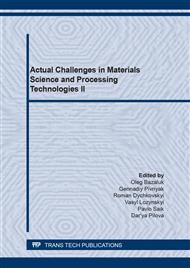p.109
p.117
p.127
p.141
p.147
p.157
p.179
p.186
p.194
Stress Concentration in Bounded Compositeplates with Carbon Reinforcement
Abstract:
The research purpose is to develop an approach for determining the stress concentration near the holes in composite structure elements reinforced with carbon fibres. The research is performed on the basis of a numerical-analytic approach using the method of singular integral equations. The paper studies the stress concentration near the holes in composite plate elements of the structures, which are reinforced with carbon fibres. The stresses are determined based on the singular integral equations. The integral equations are solved numerically using the mechanical quadrature method. The stress in the strip is studied at: longitudinal tension; pure bending; three-point bending; with periodically spaced holes. An approach to calculating the stresses in composite strips weakened by holes of different shapes, based on the method of integral equations, has been developed. The equation kernels are formulated on the basis of Green's functions, under which the boundary conditions on straight-line boundaries are satisfied identically. A methodology for calculating the stress concentration near the holes of arbitrary shape in plate elements of the structures has been developed. The results obtained can be used when calculating the strength of composite materials reinforced with carbon fibres.
Info:
Periodical:
Pages:
147-156
Citation:
Online since:
September 2021
Keywords:
Price:
Сopyright:
© 2021 Trans Tech Publications Ltd. All Rights Reserved
Share:
Citation:


